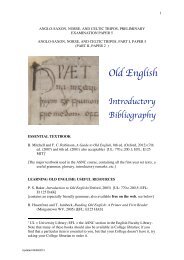Scandinavian history in the Viking age - Department of Anglo-Saxon ...
Scandinavian history in the Viking age - Department of Anglo-Saxon ...
Scandinavian history in the Viking age - Department of Anglo-Saxon ...
You also want an ePaper? Increase the reach of your titles
YUMPU automatically turns print PDFs into web optimized ePapers that Google loves.
<strong>Scand<strong>in</strong>avian</strong> History <strong>in</strong> <strong>the</strong> Vik<strong>in</strong>g Age<br />
[B511] E.A. Kock, Den norsk-isländska skaldediktn<strong>in</strong>gen, 2 vols (1946-49) [UL 752:2.b.90.10-11]; a<br />
famous attack on (or antidote to) F<strong>in</strong>nur Jónsson’s corpus; <strong>the</strong> edition lacks any notes or critical<br />
apparatus, and is founded on a huge series <strong>of</strong> scattered articles by Kock called <strong>the</strong> Notationes Norrœnæ:<br />
anteckn<strong>in</strong>gar till Edda och skaldediktn<strong>in</strong>g, Lunds universitets årsskrift n.f. avd. 1, 19:2-39:3 (1923-43)<br />
[UL P500.b.76.17 ff.]<br />
[B512] K. E. Gade, ‘Skaldic poetry <strong>of</strong> <strong>the</strong> <strong>Scand<strong>in</strong>avian</strong> middle <strong>age</strong>s – a new edition’, Skand<strong>in</strong>avistik<br />
32:1 (2002), 3-18.<br />
[B513] The expand<strong>in</strong>g database <strong>of</strong> <strong>the</strong> new corpus edition, Skaldic Poetry <strong>of</strong> <strong>the</strong> <strong>Scand<strong>in</strong>avian</strong> Middle<br />
Ages, is accessible onl<strong>in</strong>e at skaldic.arts.usyd.edu.au. The site currently <strong>in</strong>corporates electronic texts <strong>of</strong><br />
<strong>the</strong> skaldic corpus <strong>in</strong> F<strong>in</strong>nur Jónsson’s edition (B510), toge<strong>the</strong>r with a full concordance, and l<strong>in</strong>ks to<br />
thousands <strong>of</strong> digital im<strong>age</strong>s <strong>of</strong> <strong>the</strong> manuscripts <strong>in</strong> which <strong>the</strong> verses are preserved.<br />
Translations<br />
[B515] G. Vigfússon and F. York Powell, Corpus poeticum boreale: <strong>the</strong> poetry <strong>of</strong> <strong>the</strong> old nor<strong>the</strong>rn<br />
tongue from <strong>the</strong> earliest times to <strong>the</strong> thirteenth century. II: Court poetry (1883) [UL 752:2.c.85.3];<br />
conta<strong>in</strong>s both texts and translations, although <strong>of</strong>ten outdated<br />
[B516] L.M. Hollander, The skalds: a selection <strong>of</strong> <strong>the</strong>ir poems (1945) [UL 752:2.d.90.2]<br />
Individual poets or poems<br />
[B520] Aside from attributions <strong>in</strong> literary sources, <strong>the</strong> text Skáldatal purports to provide a list <strong>of</strong> known<br />
court poets and <strong>the</strong> historical contexts <strong>in</strong> which <strong>the</strong>y worked; for text, see (B515): II,442-46. For <strong>the</strong> most<br />
part, only major court poets are listed, with loose stanzas tak<strong>in</strong>g a distant back seat. For <strong>the</strong> huge<br />
problems <strong>in</strong>volved with compil<strong>in</strong>g long poems out <strong>of</strong> scattered stanzas, which are <strong>of</strong>ten <strong>in</strong> a highly<br />
uncerta<strong>in</strong> order or state <strong>of</strong> preservation, see (B490) and (B493).<br />
Tenth-century verse<br />
[B521] Þjóðólf <strong>of</strong> Hv<strong>in</strong>ir is said to have composed for k<strong>in</strong>gs Rognvald <strong>of</strong> Vestfold and Harald fairhair <strong>in</strong><br />
<strong>the</strong> late n<strong>in</strong>th and early tenth centuries; see B. Fidjestøl, ‘The k<strong>in</strong>g’s skald from Kv<strong>in</strong>esdal and his<br />
poetry’, (O10):68-92. Text: (B510):7-21. [a] Yngl<strong>in</strong>ga tal traces <strong>the</strong> descent <strong>of</strong> <strong>the</strong> k<strong>in</strong>gs <strong>of</strong> Vestfold<br />
back to <strong>the</strong> Yngl<strong>in</strong>g dynasty <strong>of</strong> Sweden and so to a div<strong>in</strong>e orig<strong>in</strong>; it is preserved with <strong>the</strong> accompany<strong>in</strong>g<br />
prose Yngl<strong>in</strong>ga saga only <strong>in</strong> Heimskr<strong>in</strong>gla (B322). Text and Swedish transl.: A. Noreen, Yngl<strong>in</strong>gatal,<br />
KVHAA handl<strong>in</strong>gar 28 (1925) [UL Ub.8.382]. Commentary: J.E. Turville-Petre, ‘On Yngl<strong>in</strong>gatal’, MS<br />
11 (1978-79), 48-67; A. Faulkes, ‘Descent from <strong>the</strong> Gods’, MS 11 (1978-79), 92-125; J.E. Turville-Petre,<br />
‘The genealogist and <strong>history</strong>: Ari to Snorri’, SBVS 20 (1978-81), 7-23; C. Krag, Yngl<strong>in</strong>gatal og<br />
Yngl<strong>in</strong>gasaga: en studie i historiske kilder, Studia humaniora 2 (1991) [UL 752:16.c.95.36] (E.s.); see<br />
also (E30 ff.) and (K75 ff., K81). [b] Haustl²ng on <strong>the</strong> o<strong>the</strong>r hand conta<strong>in</strong>s various mythological tales,<br />
and is more Eddaic <strong>in</strong> content. Text: V. Kiil, ‘Tjodolvs Haustl²ng’, ANF 74 (1959), 1-104. Text and<br />
transl.: R. North, The Haustl²ng <strong>of</strong> Þjóðólfr <strong>of</strong> Hv<strong>in</strong>ir (1997) [UL 752:2.c.95.14], with commentary; also<br />
transl.: (B516):42-48.<br />
[B522] Þorbj²rn hornkl<strong>of</strong>i is said to have been one <strong>of</strong> Harald fairhair’s poets, and is widely held to<br />
have been responsible for Hrafnsmál, also known as Haraldskvæði, although some manuscripts<br />
attribute <strong>the</strong>se verses to Þjóðólf (B521). Text: (B510):22-29. Transl. (B515): I,254-59; (B593):56-62;<br />
(B1):106-09. See K. von See, ‘Studien zum Haraldskvæði’, ANF 76 (1961), 96-111<br />
[B523] Egil Skallagrímsson is <strong>of</strong>ten considered to be <strong>the</strong> greatest <strong>of</strong> <strong>the</strong> Vik<strong>in</strong>g-<strong>age</strong> Icelandic poets,<br />
although largely on <strong>the</strong> basis <strong>of</strong> his loose stanzas. Text: (B510):34-60; J. Kristjánsson, Kvæðakver Egils<br />
Skallagrímssonar (1964) [UL 9752.d.583]. Egil’s work is naturally conta<strong>in</strong>ed <strong>in</strong> his saga (B413). [a]<br />
H²fuðlausn is said to have been composed at <strong>the</strong> court <strong>of</strong> Erik bloodaxe, Egil’s bitterest enemy, <strong>in</strong> York<br />
as a ransom for his life; see J. H<strong>in</strong>es, ‘Egill’s H²fuðlausn <strong>in</strong> time and place’, SBVS 24 (1994-97), 83-104.<br />
Text and transl.: R. Poole ‘Variants and variability <strong>in</strong> <strong>the</strong> text <strong>of</strong> Egill’s H²fuðlausn’, The politics <strong>of</strong><br />
edit<strong>in</strong>g medieval texts: papers given at <strong>the</strong> twenty-seventh annual conference on editorial problems,<br />
University <strong>of</strong> Toronto, 1-2 November 1991, ed. R. Frank (1993), 65-105. Transl.: (B516):68-73. [b]<br />
Sonatorrek details <strong>the</strong> relationship <strong>of</strong> Egil with his patron god Od<strong>in</strong>; although now partially corrupted, it<br />
is (possibly) <strong>of</strong> immense <strong>in</strong>terest as an <strong>in</strong>sight <strong>in</strong>to <strong>the</strong> pagan mentality. Text and transl.: E.O.G. Turville-<br />
Petre, ‘The Sonatorrek’, Iceland and <strong>the</strong> mediaeval world: studies <strong>in</strong> honour <strong>of</strong> Ian Maxwell, edd. E.O.G.<br />
37






